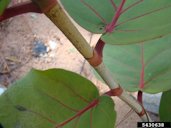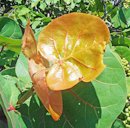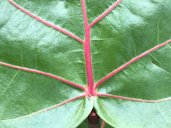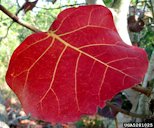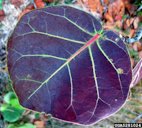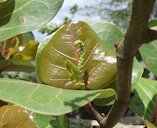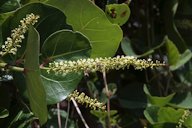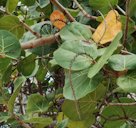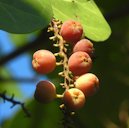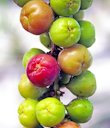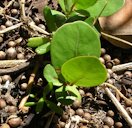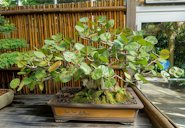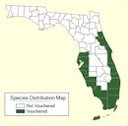| Seagrape - Coccoloba uvifera | |||||||||||||||||||||||||||||||
|---|---|---|---|---|---|---|---|---|---|---|---|---|---|---|---|---|---|---|---|---|---|---|---|---|---|---|---|---|---|---|---|
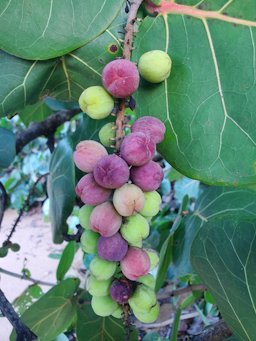 Fig. 1  Coccoloba uvifera, Juan Martín, Luquillo, Puerto Rico 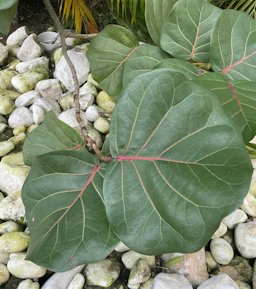 Fig. 2  Sea Grape C. uvifera, Jamaica, Montego Bay, Cornwall County 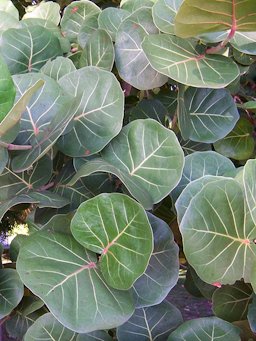 Fig. 3  Leaf habit 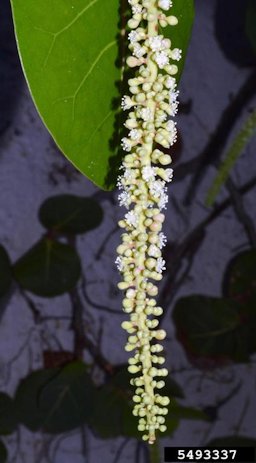 Fig. 9  Seagrape (C. uvifera) flowers 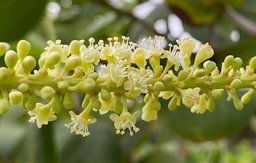 Fig. 10  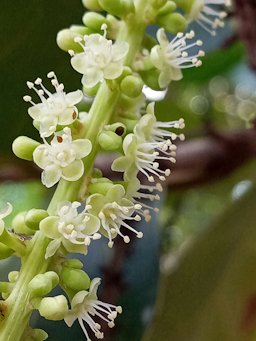 Fig. 11  C. uvifera, Willemstad, Curaçao 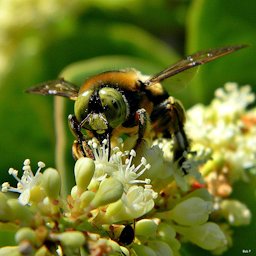 Fig. 12  View of the southern carpenter bee (Xylocopa micans) pollinating a seagrape tree 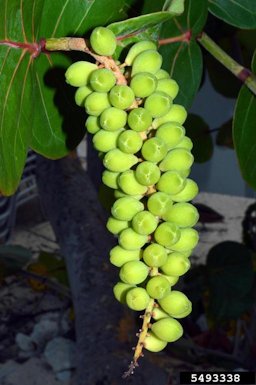 Fig. 16  Seagrape (C. uvifera) fruits 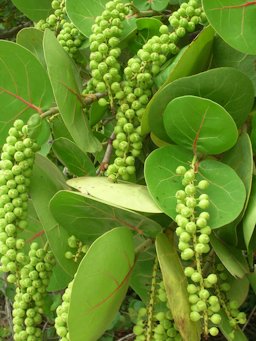 Fig. 17  Leaves and fruit, Aviary seep West Beach Sand Island, Midway Atoll, Hawai'i 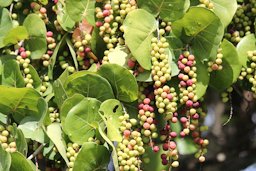 Fig. 18  Seagrape C. uvifera, Brevard County, FL, USA 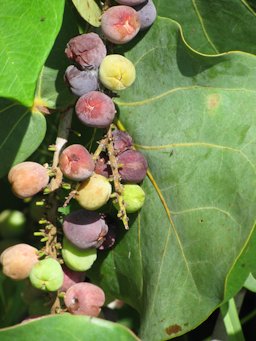 Fig. 19  C. uvifera (Sea grape), fruit, Boynton Beach, Florida 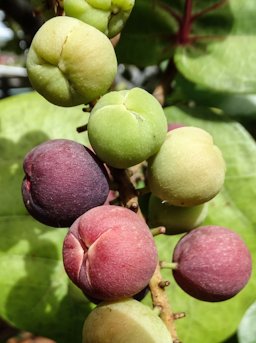 Fig. 20  C. uvifera, Gustavia, Saint-Barthélemy 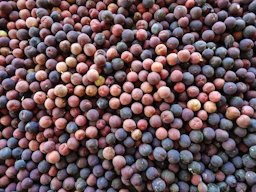 Fig. 26  C. uvifera, Gustavia, Saint-Barthélemy 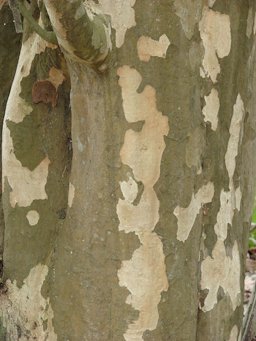 Fig. 27  C. uvifera (Sea grape) bark, Cable Company buildings Sand Island, Midway Atoll, Hawai'i 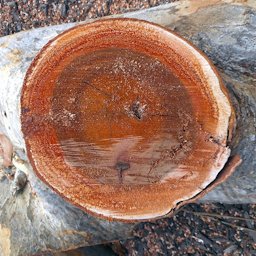 Fig. 28  Seagrape tree branch transverse cut 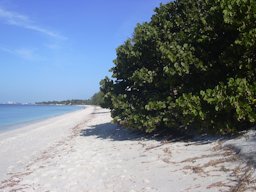 Fig. 29  C. uvifera (Sea grape) habit, Turtle Beach, Florida 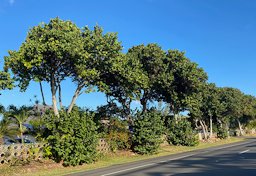 Fig. 30  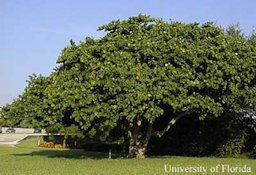 Fig. 31  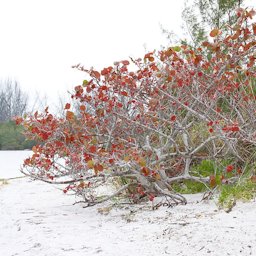 Fig. 32  C. uvifera Beach, Pinellas County 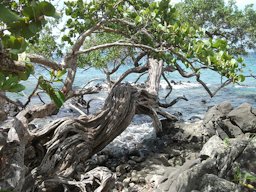 Fig. 33  Raisinier bord de mer sur le littoral de La Martinique, à Anse Figuier, Rivière-Pilote 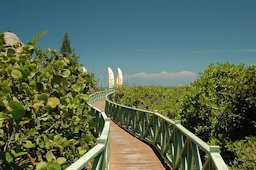 Fig. 34  Unnamed Road, Cuba 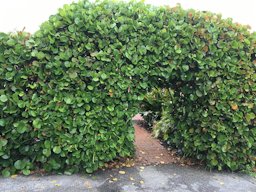 Fig. 35  C. uvifera arch and hedge, cultivated, private garden, Boynton Beach, Florida, USA 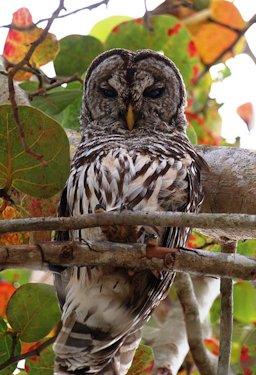 Fig. 38  Barred owl (Strix varia) in a Sea-grape tree (C. uvifera), Chekika, East Everglades |
Scientific
name Coccoloba uvifera Pronunciation koe-koe-LOE-buh yoo-VIFF-er-uh 1 Common names English: seagrape, Jamaican kino, platterleaf, shore sea-grape; Puerto Rico: uva de mar, uvero; Virgin Islands: grape; Spanish: uva de playa, uva, uvero; Dominican Republic: uva del mar, uva caleta; Cuba: uva caleta; Honduras, Costa Rica: papaturro; Nicaragua: papaturro, extanjero; French: raisinier bord de mer; Jamaica, Trinidad, British Guiana: seaside-grape; British Honduras: grape; Haiti: raisin la mer; Guadeloupe, French Guiana: raisin bord-de-mer, raisinier bord-de-mer; Dutch West Indies: zeedreifi, dreifi, dreifi di laman, seagrape; German: Meertraubenbaum; Portuguese: uva-da-praia; Portuguese (Brazil): cocoloba, uva do mar; Surinam: druif, zeedruif; Swedish: havsdruva 8,12 Synonyms Coccolobis uvifera (L.) Crantz, Polygonum uviferum L. 3 Family Polygonaceae (buckwheat family) Origin Native to Florida, Central America, northwest portion of South America and the Caribbean 1 USDA hardiness zones 10a-11 1 Uses Fruit; screen; specimen; shade; hedge; reclamation 1 Height Varying greatly in size from a low prostrate shrub on wind-swept beaches to a small, straggly or wide spreading tree 8 35-50 ft (10.7-15.3 m) 1 Spread 20-30 ft (6-9 m) 1 Crown Symmetrical 1 Plant habit Multi-stemmed vase shape if left unpruned 1 Growth rate Moderate 1 Trunk/bark/branches Branches droop; showy; bark smooth and mottled with whitish, gray, and brown, thin-peeling plates 1 Pruning requirement Needed for strong structure 1 Leaves Large; alternate; broad; leathery; evergreen; distinctive red veins; 8-12 in. (20-30 cm) 1 Flowers Cream-colored; not showy; emerge in clusters on racemes; primarily spring to early summer, but may also occur year-round 1 Fruit Elliptical; ¾ in. (2 cm); fleshy achene; green to reddish purple 1 Season Emerges in early summer and ripens by early fall 1 Light requirement Full sun, partial sun, or partial shade 1 Soil tolerances Clay; sand; loam; alkaline; acidic; well-drained 1 Drought tolerance High 1 Soil salt tolerance High Aerosol salt tolerance High tolerance to salt spray 9 Cold tolerance Mature specimens have survived 23 °F (-5 °C) 2 Roots Not a problem 1 Invasive potential * Native Pest resistance Resistant to pests/diseases 1 Known hazard Fruit/leaves a litter problem 1 Reading Material Coccoloba uvifera: Seagrape, University of Florida pdf Coccoloba uvifera, Floridata Sea-Grapes: Maritime Marvels, Eat The Weeds Note: The tree is protected in Florida. It is illegal to destroy them. More specifically, you cannot harvest from public land. On Private land you need the owner’s permission. 5 Beach-dune plant damage or removal located seaward of a state of Florida coastal construction control line (CCCL) is regulated under section 161.053, Florida Statutes (F.S.). Additional protections for sea oats, Uniola paniculata, and seagrapes, Coccoloba uvifera, are found in section 161.242, F.S. 13 Origin Seagrape is a tropical plant, native to coastal hammocks, coastal scrub, coastal grasslands and beach strands from Argentina north throughout the West Indies and the Florida Keys to Pinellas County on the Gulf Coast and southern Volusia County on the Atlantic Coast of Florida. It does not reach tree stature at the northern limits of its range. 4 Description The seagrape is one of south Florida's most attractive native plants. It is tolerant of adverse conditions. It will grow in exposed, beachfront locations, where few other tree, much less fruit trees, can survive. The fact that it produces a useful fruit is an added bonus. The fruit does not rank among the elite fruits of the subtropics and is hardly palatable when fresh. However, it can be used to make an excellent jelly. 2 The contorted, twisting trunk (Fig. 33), (which can grow to two feet in diameter) and upright branching habit makes seagrape an interesting, picturesque shade tree or specimen planting (Fig. 30,31) or, it can be pruned into a dense hedge (Fig. 35), screen, or windbreak. 1 On shorelines it is often planted to help control dune erosion. Leaves The large alternate leaves are stiff and rounded 4-8 x 2.75-6.9 in. (10-20 by 7-17 cm) with prominent, reddish veins (Fig. 4,6) which make it attractive as an ornamental, they have a sheath that surrounds the stem at the point of insertion (Fig. 4). 9 The leaves frequently turn completely red before they fall in winter. The new young foliage is a beautiful bronze color (Fig. 5) which is set off nicely against the dark green, shiny leaves. 1
Fig. 4. Seagrape (C. uvifera) leaves have clamping bases Fig. 5. Young leaves (reddish) and green fruit Fig. 6. C. uvifera, Ding Darling National Wildlife Refuge, Lee, Florida Fig. 7,8. Seagrape (C. uvifera) foliage Flowers Flowers appear on spikes or racemes, measuring between 8 and 12 inches in length. The flowers are small, off-white, and pleasantly fragrant. The seagrape is dioecious: male and female flowers are borne on separate trees. Although a male tree is required for pollination, only the female tree produces fruit. Flowers may appear sporadically throughout the year, but are most common from February through July. 2 Fruit ripen about 2 months after anthesis. 9
Fig. 13. Raisinier (jeune pousse) Fig. 14. Seagrape (C. uvifera) inflorescense Fig. 15. Sea Grape, L'Ermitage-Les-Bains, Réunion (male plants show dead flower stalks) Fruit The fruit is round or oval, about 3/4 in (1.9 cm) in diameter, and roughly grapelike in appearance. The apex is lightly grooved (Fig. 23). The fruit is produced in elongated clusters that hang pendulously from the branches of the female tree. A cluster may contain as many as 70 fruit. The fruit is light green at first, turning pink or purple when ripe. The flavor varies from tart and acidic to mild and sweet. Embraced within the pulp is a large, hard, elliptic seed, pointed on top. Fruit typically ripen during the summer and fall. 2 Ripening is not simultaneous (Fig. 1) in the bunch so that fruit have to be picked individually or the branches shaken for the ripe fruit to fall. 9
Fig. 21. Sea Grape C. uvifera, Munyon Island, North Palm Beach, FL 33408, USA Fig. 22,23. C. uvifera, Uva de playa, seagrape, raisin de bord de mer Varieties Selected cultivars available from Florida include a dwarfed, low -growing form and one with disitnctive reddish leaves. 11 There is a variegated cultivar available. 1 Harvesting A mature specimen will produce several gallons of fruit over the course of a season. The fruit should be harvested when fully colored. The fruit tend to drop shortly after ripening. The seagrape can be eaten out of hand when fully ripe. although the fresh fruit is of poor quality. More often it is used to make jellies or preserves. 2 Pollination Bees and other insects are the principal pollinators of this dioecious species. 9 Male trees need to be also planted. 9 Nectar plant for Florida duskywing (Ephyriades brunneus), julia (Dryas iulia), Schaus' swallowtail (Papilio aristodemus ponceanus), the introduced fulvous hairstreak (Electrostrymon angelica), and other butterflies.(IRC). 11 Propagation The seagrape is usually grown from seed. Seeds sown at a shallow depth will germinate readily, usually between 3 and 6 weeKs after they are panted. The plant can also be reproduced by air-layering, by veneer grafting, and by rooting hardwood cuttings. 2 Since propagation is from cuttings, female plants should be selected for fruits. 8
Fig. 24. C. uvifera (Sea grape) seedlings Mokuauia, Oahu, Hawai'i Fig. 25. C. uvifera (seedling), Kona, Hawai'i Planting Requiring full sun and sandy, well-drained soils, seagrape is excellent for seaside locations since it is highly salt- and drought-tolerant. 1 Pruning Pruning is required two or three times during the first 10 years after planting to train the multiple trunks so they are well-attached to the tree. Be sure branches do not develop embedded bark, since they will be poorly attached to the trunk and could split from the trunk. But the wood and the tree is generally very strong and durable following this developmental and corrective pruning. The tree will then perform well with little care, except for occasional pruning of lower branches to create clearance for vehicles. Some people object to the litter created by the large, slowly-decomposing leaves which fall from the tree during the year. 1 Pests Seagrape is very susceptible to attack by dry-wood termitesand, as C. uvifera often harbours these insects, care should be taken if the trees are planted near buildings. 7 Stems are subject to seagrape borer which can kill branches. A nipple gall causes raised, red nipples on the upper leaf surface. 1 Seagrape Borer, Hexeris enhydris, University of Florida pdf Diseases No diseases are of major concern. 1 Food Uses Jelly and a winelike beverage can be prepared from the fruits, which also are eaten raw. Bunches of fruits in conelike packets formed by rolling the leaves have been sold on the streets. 8 Medicinal Properties ** A gum from the bark is used for throat ailments, and the roots are used to treat dysentery. 4 Other Uses The heartwood is reddish brown, hard and heavy, very popular regionally as a fuel wood. 7 Wood from larger trees is prized for cabinet work. 4 Sea-Grapes are an important honey source, they make a good bonsai candidates, and a patent was filed in 1999 to use leaf extracts to control blood sugar levels in diabetics. 5 West Indian kino, a red and astringent substance, was extracted from the bark and used in tanning and dyeing. 7 In Hawai'i, unripe green sea-grapes are strung in leis and sold (cheaply) as "false mokihana." Although it resembles mokihna in shape, size, and color, sea-grape lacks the distinctive anise scent of the genuine article (Pelea anisata), nonetheless, sales are brisk. The false mokihana strand is often twined with a strand of the flower bud cluster of octopus tree (Shefflera actinophylla) or some other colorful leis to enliven its plain green color. 10 General Coccoloba comes from “cocolobis” a type of Spanish grape; uvifera means “bearing grapes” or “like grapes". 5 National champion is 62 x 66 feet in Florida. 6 Early Spanish colonists sometimes used the fresh thick leaves as a substitute for paper, scratching messages with a pin or other sharp point. 8
Fig. 36. Bonsai specimen in the Marie Selby Botanical Gardens, Sarasota, Florida, USA
Fig. 37. Seagrape distribution map, wild populations List of Growers and Vendors |
||||||||||||||||||||||||||||||
| Bibliography 1 Gilman, Edward F., et al. "Coccoloba uvifera: Seagrape." Environmental Horticulture Dept., UF/IFAS Extension, Original pub. Nov.1993, Revised Dec. 2018, AskIFAS, edis.ifas.ufl.edu/publication/st175. Accessed 18 Dec. 2022. 2 Boning, Charles R. Florida's Best Fruiting Plants- Native and Exotic Trees, Shrubs, and Vines. Sarasota, Pineapple Press, 2006. 3 "Coccoloba uvifera L." The World Flora Online, WFO (2022), www.worldfloraonline.org/taxon/wfo-0000613437. Accessed 19 Dec. 2022. 4 Christman, Steve. "Coccoloba uvifera." Floridata, no. 155, Published 26 Aug. 1999, Updated 7 Nov. 2000, 12 Jan. 2004, floridata.com/plant/155. Accessed 19 Dec. 2022. 5 Deane, Green. "Sea-Grapes: Maritime Marvels." Eat the Weeds and other things, too, www.eattheweeds.com/sea-grapes-maritime-marvels/. Accessed 19 Dec. 2022. 6 Gilman, Edward F. "Coccoloba uvifera, Sea Grape." Landscape Plants, Environmental Horticulture Dept., UF/IFAS, AskIFAS, hort.ifas.ufl.edu/woody/Pages/cocuvi/cocuvi.shtml. Accessed 20 Dec. 2022. 7 Barwick, Margaret. Tropical & Subtropical Trees. A Worldwide Encyclopaedic Guide. London, 2004. 8 Little, Elbert L., and Frank H. Wadsworth. "Common trees of Puerto Rico and the Virgin Islands." Series: Agriculture handbook no. 249, United States. Dept. of Agriculture, July 1964, pp. 62-63, Biodiversity Heritage Library, doi.org/10.5962/bhl.title.4135. Accessed 21 Dec. 2022. 9 The Encyclopedia of Fruit & Nuts. Edited by Jules Janick and Robert E. Paull, Cambridge, CABI, 2008. 10 Staples, George W., and Derral R. Herbst. A tropical Garden Flora, Plants Cultivated in the Hawai'ian Islands and other Tropical Places. Honolulu, Bishop Museum Press, 2005. 11 "Coccoloba uvifera." Florida Native Plant Society, FNPS, www.fnps.org/plant/coccoloba-uvifera. Accessed 22 Dec. 2022. 12 "Taxon: Coccoloba uvifera (L.) L. common names." USDA, Agricultural Research Service, National Plant Germplasm System, 2022, Germplasm Resources Information Network, National Germplasm Resources Laboratory, Beltsville, Maryland, (GRIN Taxonomy), npgsweb.ars-grin.gov/gringlobal/taxon/taxonomydetail?id=10993. Accessed 24 Dec. 2022. 13 "Harvesting of sea oats and sea grapes prohibited; possession prima facie evidence of violation." The Florida Senate, Section 242, 161.242, flsenate.gov/Laws/Statutes/2021/0161.242. Accessed 10 Jan. 2023. Photographs Fig. 1 Irizarry, Ivelisse. "Sea Grape Coccoloba uvifera, Jupiter, FL." iNaturalist, Research Grade, 25 Sept. 2021, (CC BY-NC 4.0), www.inaturalist.org/observations/96168947. Accessed 30 Dec. 2022. Fig. 2 maggie499. "Sea Grape Coccoloba uvifera, Jamaica, Montego Bay, Cornwall County, JM." iNaturalist, Research Grade, 20 Dec. 2021, (CC BY-NC 4.0), Image cropped, www.inaturalist.org/observations/103370106. Accessed 24 Dec. 2022. Fig. 3 Navez, B. "Coccoloba uvifera." Wikimedia Commons, 25 May 2006, (CC BY-SA 3.0), commons.wikimedia.org/wiki/File:Coccoloba_uvifera_leaves_(edit).jpg. Accessed 23 Dec. 2022. Fig. 4 Wallace, Rebekah D. "Seagrape (Coccoloba uvifera) inflorescense." University of Georgia, no. 5612205, 27 Sept. 2021, Bugwood, (CC BY-NC 3.0 US), www.forestryimages.org/browse/detail.cfm?imgnum=5612205. Accessed 20 Dec. 2022. Fig. 5 di Palma, Daniel. "Young leaves (reddish) and green fruit." Wikimedia Commons, 20 June 2017, (CC BY-SA 4.0), Image cropped, commons.wikimedia.org/wiki/Category:Coccoloba_uvifera#/media/File:Coccoloba_uvifera_01A_-_young_leaf.jpg. Accessed 23 Dec. 2022. Fig. 6 JeffreyGammon. "Sea Grape Coccoloba uvifera, Munyon Island, North Palm Beach, FL 33408, USA." iNaturalist, Research Grade, 15 Nov. 2020, (CC BY-NC 4.0), Image cropped, www.inaturalist.org/observations/64955595. Accessed 24 Dec. 2022. Fig. 7 Clark, Dan. "Seagrape (Coccoloba uvifera) foliage." Northeastern University, no. 5281024, 29 Nov. 2010, Bugwood, (CC BY-NC 3.0 US), www.forestryimages.org/browse/detail.cfm?imgnum=5281024. Accessed 20 Dec. 2022. Fig. 8 Clark, Dan. "Seagrape (Coccoloba uvifera) foliage." Northeastern University, no. 5281025, 2 Dec. 2010, Bugwood, (CC BY-NC 3.0 US), www.forestryimages.org/browse/detail.cfm?imgnum=5281025. Accessed 20 Dec. 2022. Fig. 9 Ciesla, William M. "Seagrape (Coccoloba uvifera) flowers." Forest Health Management International, no. 5493337, 20 Mar. 2013, Bugwood, (CC BY-NC 3.0 US), www.forestryimages.org/browse/detail.cfm?imgnum=5493337. Accessed 20 Dec. 2022. Fig. 10,30 SelecTree. UFEI. "Coccoloba uvifera Tree Record." Cal Poly State University, San Luis Obispo, 1995-2022, Cal Poly State University, San Luis Obispo, selectree.calpoly.edu/tree-detail/377. Accessed 22 Dec. 2022. Fig. 11 Cijntje, Quinlan. "Sea Grape Coccoloba uvifera, Willemstad, Curaçao." iNaturalist, Research Grade, 16 Feb. 2021, (CC BY-NC 4.0), www.inaturalist.org/observations/69682392. Accessed 24 Dec. 2022. Fig. 12 Peterson, Bob. "Another view of the southern carpenter bee (Xylocopa micans) pollinating a seagrape tree." Wikimedia Commons, via Flidkr, 8 May 2014, (CC BY-SA 2.0), commons.wikimedia.org/wiki/File:Bee's_Eye_View_(14210813883).jpg. Accessed 23 Dec. 2022. Fig. 13 MiguelGerme. "Raisinier (jeune pousse)." Wikimedia Commons, 15 Mar. 2015, (CC BY-SA 4.0), commons.wikimedia.org/wiki/File:Raisinier_(jeune_pousse).JPG. Accessed 23 Dec. 2022. Fig. 14 Sévi, Ianaré. "Sea Grape Flowers, Fleurs de Raisin de bord de mer." Wikimedia Commons, 5 May 2009, (CC BY-SA 3.0), commons.wikimedia.org/wiki/File:Coccoloba_uvifera_flower.jpg. Accessed 23 Dec. 2022. Fig. 15 BASUYAUX, Jean-Philippe. "Sea Grape Coccoloba uvifera, L'Ermitage-Les-Bains, Réunion." iNaturalist, Research Grade, 18 Nov. 2019, (CC BY-NC 4.0), Image cropped, www.inaturalist.org/observations/35827089. Accessed 24 Dec. 2022. Fig. 16 Ciesla, William M. "Seagrape (Coccoloba uvifera) flowers." Forest Health Management International, no. 5493338, 20 Mar. 2013, Bugwood, (CC BY-NC 3.0 US), www.forestryimages.org/browse/detail.cfm?imgnum=5493338. Accessed 20 Dec. 2022. Fig. 17 Starr, Forest, and Kim. "Coccoloba uvifera (Sea grape), leaves and fruit, Aviary seep West Beach Sand Island, Midway Atoll, Hawai'i." Starr Environmental, no. 080608-9447, 8 June 2008, (CC BY 3.0), www.starrenvironmental.com/images/image/?q=24917481735. Accessed 23 Dec. 2022. Fig. 18 Perry IV, Edward. "Sea Grape Coccoloba uvifera, Brevard County, FL, USA." iNaturalist, Research Grade, 23 Nov. 2020, (CC BY-NC 4.0), www.inaturalist.org/observations/65486153. Accessed 24 Dec. 2022. Fig. 19 Starr, Forest, and Kim. "Coccoloba uvifera fruit, Boynton Beach, Florida." Starr Environmental, no. 090924-0219, 24 Sept. 2009, (CC BY 3.0), www.starrenvironmental.com/images/image/?q=24343730104. Accessed 23 Dec. 2022. Fig. 20 Questel, Karl. "Sea Grape Coccoloba uvifera, Gustavia 97133, Saint-Barthélemy." iNaturalist, Research Grade, 17 Dec. 2021, (CC BY-NC 4.0), www.inaturalist.org/observations/103203191. Accessed 24 Dec. 2022. Fig. 21,26 JeffreyGammon. "Sea Grape Coccoloba uvifera, Ding Darling National Wildlife Refuge, Lee, Florida." iNaturalist, Research Grade, 22 Jan. 2022, (CC BY-NC 4.0), www.inaturalist.org/observations/105403615. Accessed 24 Dec. 2022. Fig. 22 di Palma, Daniel. "Coccoloba uvifera / Uva de playa / Sea Grape / Raisin de bord de mer." Wikimedia Commons, 23 Sept. 2008, (CC BY 3.0), commons.wikimedia.org/wiki/File:Seagrape-bunch01.JPG. Accessed 24 Dec. 2022. Fig. 23 di Palma, Daniel. "Coccoloba uvifera / Uva de playa / Sea Grape / Raisin de bord de mer ." Wikimedia Commons, 23 Sept. 2008, (CC BY-SA 3.0), GFDL, commons.wikimedia.org/wiki/File:Seagrape-bunch02.JPG. Accessed 23 Dec. 2022. Fig. 24 Starr, Forest, and Kim. "Coccoloba uvifera (Sea grape), seedlings Mokuauia, Oahu, Hawai'i." Starr Environmental, no. 050222-4145, 22 Feb. 2005, (CC BY 3.0), Image cropped, www.starrenvironmental.com/images/image/?q=24711592346. Accessed 24 Dec. 2022. Fig. 25 Starr, Forest, and Kim. "Coccoloba uvifera (seedling), Hawai'i, Kona." Starr Environmental, no. 000409-9002, 9 Apr. 2000, (CC BY 3.0), www.starrenvironmental.com/images/image/?q=24446332351. Accessed 23 Dec. 2022. Fig. 27 Starr, Forest, and Kim. "Coccoloba uvifera (Sea grape), bark, Cable Company buildings Sand Island, Midway Atoll, Hawai'i." Starr Environmental, no. 080610-8177, 10 June 2008, (CC BY 3.0), www.starrenvironmental.com/images/image/?q=24551287789. Accessed 24 Dec. 2022. Fig. 28 di Palma, Daniel. "Seagrape tree branch transverse cut." Wikimedia Commons, 20 Sept. 2017, (CC BY-SA 4.0), Image cropped, commons.wikimedia.org/wiki/File:Coccoloba_uvifera_-_view_of_tree_trunk_branch_transverse_cut_showing_growth_rings_01.jpg. Accessed 23 Dec. 2022. Fig. 29 Starr, Forest, and Kim. "Coccoloba uvifera (Sea grape), habit Turtle Beach, Florida." Starr Environmental, no. 031108-2005, 8 Nov. 2003, (CC BY 3.0), www.starrenvironmental.com/images/image/?q=24048021333. Accessed 24 Dec. 2022. Fig. 31 Howard, F. W. "Seagrape, Coccoloba uvifera L." Dept.of Entomology and Nematology, UF/IFAS Extension, Seagrape Borer, Hexeris enhydris Grote (Insecta: Lepidoptera: Thyrididae), no. EENY345, Original pub. Mar. 2005, Revised Aug. 2014, Reviewed Feb. 2021, AskIFAS, edis.ifas.ufl.edu/publication/in622. Accessed 20 Dec. 2022. Fig. 32 Denton, Shirley. "Coccoloba uvifera Beach, Pinellas County." Florida Native Plant Society, FNPS, www.fnps.org/plant/coccoloba-uvifera. Accessed 22 Dec. 2022. Fig. 33 MiguelGerme. "Raisinier bord de mer sur le littoral de La Martinique, à Anse Figuier, Rivière-Pilote." Wikimedia Commons, 15 Mar. 2015, (CC BY-SA 4.0), commons.wikimedia.org/wiki/File:Raisinier_de_Martinique.JPG. Accessed 23 Dec. 2022. Fig. 34 Marshall, Eric. "Unnamed Road, Cuba." Wikimedia Commons, via Panoramo, 29 Aug. 2009, (CC BY 3.0), commons.wikimedia.org/wiki/File:Unnamed_Road,_Cuba_-_panoramio_(51).jpg. Accessed 23 Dec. 2022. Fig. 35 Zona, Scott. "Coccoloba uvifera arch & hedge, cultivated, private garden, Boynton Beach, Florida, USA." Flickr, 18 Mar. 2019, (CC BY-NC 2.0), www.flickr.com/photos/12017190@N06/33546629158. Accessed 30 Dec. 2022. Fig. 36 Daderot. "Bonsai specimen in the Marie Selby Botanical Gardens, Sarasota, Florida, USA." Wikimedia Commons, via Panoramo, 20 Mar. 2017, (CC0), commons.wikimedia.org/wiki/File:Coccoloba_uvifera_-_Marie_Selby_Botanical_Gardens_-_Sarasota,_Florida_-_DSC01055.jpg. Accessed 24 Dec. 2022. Fig. 37 Wunderlin, R. P., et al. "Coccoloba uvifera." Institute for Systematic Botany, University of South Florida, Tampa, S. M. Landry, and K. N. Campbell (application development), USF Water Institute, 2022, Atlas of Florida Plants, florida.plantatlas.usf.edu/Plant.aspx?id=3791. Accessed 23 Dec. 2022. * UF/IFAS Assessment of Non-native Plants in Florida's Natural Areas ** Information provided is not intended to be used as a guide for treatment of medical conditions. Published 10 Jan. 2023 LR |
|||||||||||||||||||||||||||||||
